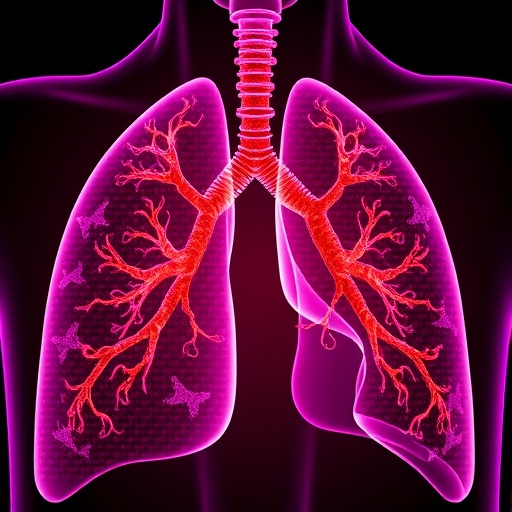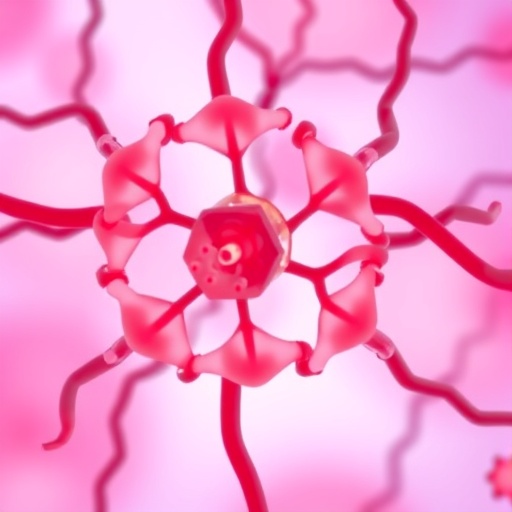In a groundbreaking study, researchers have identified EXOSC5, a member of the exosome complex family, as a promising new biomarker linked to poor prognosis in lung adenocarcinoma (LUAD). The findings, presented in the journal BMC Cancer, highlight the potential of EXOSC5 not only as a prognostic indicator but also as a therapeutic target, marking a significant advancement in the fight against this aggressive form of cancer.
Lung adenocarcinoma is known for its high mortality rates and complex molecular landscape. Despite advances in treatment options, the prognosis for patients remains poor, and the development of new biomarkers is essential for improving individualized patient care. EXOSC5 has emerged as a critical player in cancer biology, yet its specific role in LUAD was previously unclear. The current research fills a crucial gap by demonstrating the association between EXOSC5 expression and patient outcomes.
The researchers utilized data from The Cancer Genome Atlas (TCGA) to analyze the expression levels of EXOSC5 in LUAD patients. Employing advanced bioinformatics tools, they conducted a thorough investigation into the relationships between clinical data and EXOSC5 expression. This innovative approach not only established a correlation between high EXOSC5 levels and adverse outcomes but also paved the way for further exploration of its biological roles in lung cancer.
Validation of EXOSC5 expression was conducted through immunohistochemistry (IHC) and western blotting techniques. These laboratory methods confirmed the increased presence of EXOSC5 in cancerous tissues compared to non-cancerous controls. The consistent expression patterns observed in the patient samples reinforced the hypothesis that EXOSC5 could serve as a reliable biomarker for LUAD.
Moreover, the study highlighted the functional implications of EXOSC5 in tumor progression. Through gene set enrichment analysis (GSEA) and in vitro experiments, the researchers discovered that EXOSC5 plays a significant role in regulating vital cellular processes, including the cell cycle and proliferation. This activity leads to enhanced tumor growth and suggests a novel mechanism by which EXOSC5 contributes to lung cancer pathogenesis.
The implications of these findings extend beyond prognosis. The study revealed that high levels of EXOSC5 are also correlated with increased resistance to anti-PD1 immunotherapy, which is a growing concern in the treatment of lung cancer. This resistance complicates therapeutic strategies and emphasizes the need for targeted approaches that consider biomarker-driven patient stratification.
The risk model developed in this study, based on EXOSC5 expression, showed superior performance compared to traditional staging systems in predicting patient prognosis. This advancement underscores the potential for EXOSC5 to revolutionize how clinicians assess the risk and tailor treatment options for patients with lung adenocarcinoma.
Despite the promising results, the researchers acknowledge that further studies are necessary to fully delineate the mechanisms by which EXOSC5 influences immune evasion and tumor progression. Understanding these pathways could lead to novel therapeutic strategies aimed at targeting EXOSC5, ultimately improving outcomes for patients suffering from this malignancy.
In conclusion, the identification of EXOSC5 as an oncogenic factor in lung adenocarcinoma represents a significant leap forward in cancer research. As a novel prognostic biomarker, EXOSC5 could aid in the development of more personalized treatment strategies, enhancing the precision of interventions and promoting better survival rates in lung cancer patients. The potential for EXOSC5 to act as both a biomarker and a therapeutic target is exciting, providing hope in an area of medicine that deeply needs innovative solutions.
This research opens several avenues for future investigation, particularly into the therapeutic targeting of EXOSC5. As ongoing studies continue to unravel the complexities of lung adenocarcinoma, the focus on biomarkers such as EXOSC5 may lead to breakthroughs that transform treatment paradigms and improve patient outcomes.
The progression of this research not only emphasizes the need for interdisciplinary approaches in cancer treatment but also highlights the importance of continuous exploration into the molecular underpinnings of diseases like lung adenocarcinoma. With colorectal cancer remaining a significant challenge in oncology, the evidence supporting EXOSC5’s relevance creates a compelling case for its inclusion in future clinical trials and therapeutic developments.
As the medical community grapples with the challenges of aggressive tumors, the integration of novel biomarkers such as EXOSC5 could usher in a new era of targeted therapies and enhanced prognostic capabilities. Moving forward, it will be essential to work collaboratively across various disciplines to leverage these findings for the benefit of patients around the globe.
By advancing our understanding of key molecular players like EXOSC5, researchers lay the groundwork for forging a new path in the management of lung adenocarcinoma, ultimately striving towards improved quality of life and survival for those affected by this formidable disease.
—
Subject of Research: Lung adenocarcinoma and EXOSC5 as a biomarker
Article Title: EXOSC5: a novel biomarker for poor prognosis in lung adenocarcinoma
Article References: Xu, J., Zhang, Z., Han, K. et al. EXOSC5: a novel biomarker for poor prognosis in lung adenocarcinoma.
BMC Cancer 25, 681 (2025). https://doi.org/10.1186/s12885-025-14059-2
Image Credits: Scienmag.com
DOI: https://doi.org/10.1186/s12885-025-14059-2
Keywords: EXOSC5, lung adenocarcinoma, biomarker, immune evasion, prognostic indicator, therapy resistance.
Tags: advanced bioinformatics in cancer researchEXOSC5 biomarker in lung adenocarcinomaexosome complex in cancer biologyhigh mortality rates in lung adenocarcinomaindividualized patient care in lung cancerlung adenocarcinoma prognosisnovel biomarkers for cancer treatmentprognostic indicators for lung cancerrelationship between EXOSC5 and patient outcomessignificance of EXOSC5 in LUAD.The Cancer Genome Atlas analysistherapeutic targets in cancer treatment





